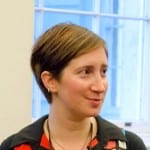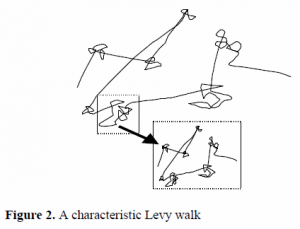Looking back on ‘Blockages in the System’: a reflective comment on working with PhD researchers beyond your discipline
By Ruth M Blackburn, on 16 June 2014
By Kevin Guyan and Ruth Blackburn
On the evening of Friday 23 May we presented ‘Blockages in the system: health research in postwar Britain’ to an audience of around 30 people in UCL’s Bloomsbury Studio. Positioned between two presentation screens, showing in bright Technicolor a journey through the streets of London in the 1950s, the audience sat in two long rows as if they were journeying on a classic Routemaster bus.
Our presentation explored links between good physical health and exercise, discussing the bus men study conducted by Jerry Morris (1910-2009), Emeritus Professor of Public Health at London School of Hygiene and Tropical Medicine and commonly referred to as the father of exercise epidemiology. Morris was the first to establish proof that the frequency and severity of heart disease was reduced among workers who did more active jobs, having reached this conclusion in the late 1940s by conducting an innovative and efficient ‘experiment’ that studied the behaviour and indicators of physical health in several thousand London Transport employees; particularly focusing on health differences between bus drivers and conductors. Our study of Morris also sought to position his work within the wider context of postwar London, showing that his research on the health of London transport workers was a product of its time and is an interesting example of broader changes in how ‘experts’ were understanding and explaining human action and behaviour.
In this blog post we will discuss the process of developing our presentation for Movement, focusing particularly on our experiences of working with a PhD researcher from another discipline. Ruth Blackburn is based in the Department of Primary Care and Population Health and her research explores the prevention of heart disease and stroke in people with serious mental illness. Kevin Guyan is based in the Department of History and is currently exploring the role of ‘expert knowledge’ in how ideas of gender and domestic space were understood in London during the 1940s and 1950s.
It is hoped that by looking back on the process of developing our presentation, we will be able to share the benefits of this approach with other researchers who are also considering developing a project that crosses different backgrounds and knowledge-sets. However, we will also identify difficulties encountered in our project and limitations that we feel can hamper this inter-disciplinary style of event development.
Developing the Idea
‘Blockages in the system’ grew organically from discussions over possible links in our PhD research. The paradigm with which each of us viewed Jerry Morris and his work was very much a product of our training and academic disciplines. Numerous pages of ideas were exchanged in an attempt to fathom cross-over points between Jerry Morris’s epidemiological study of London Transport Workers and notions of expert knowledge in postwar London. Throughout this process, we both had a sense that similarities were present, yet also did not wish to elevate themes that were overly tenuous. A series of meetings with staff working across the university were instrumental in helping us to streamline our ideas and bring in more material from UCL Collections. Each of these meetings highlighted both the expertise and enthusiasm of the Museums and Collections staff and the epic proportions of UCL Collections. Our first meeting was with Krisztina Lackoi, Research Co-ordinator for Museums and Collections, who introduced us to a breadth of ideas, people, objects and spaces that we would otherwise not have considered – we left feeling enthused by the project but overwhelmed by the wealth of material available. Ruth’s notes record an eclectic list: circuit boards, walking sticks, space science laboratories, model boats, nuns, bicycles and ice skates; each representing a few tentative steps down a primrose path.
After some deliberation we decided to add a ‘Lost Property’ strand to our presentation, and felt that RJ Berry’s mice (Grant Museum) and the Counting Gloves of Francis Galton (Galton Collection) were fitting objects to focus on. At present, Berry’s mice are not on public display so Mark Carnall, Curator at the Grant Museum, kindly arranged for Ruth to visit the Grant Museum’s storage facilities and explain what is known about the specimens. Ruth was struck by the incredible number of specimens (around 8000) collected by Berry and the difficulties in storing, researching and using this kind of collection: another possible avenue for exploration emerged, but as yet remain untapped. Our final meeting with Subhadra Das, Curator UCL Teaching and Research Collections, confirmed that Galton’s Counting Gloves were also well suited to our event and was able to provide additional information on their use and history. She also volunteered to accompany the Gloves to Movement so that our audience were able to see them first hand (no pun intended).
Challenges
Bringing our viewpoints and expertise together was an enriching and enjoyable experience, although the struggle to find mutually acceptable terms did often prove challenging! It became clear, in the process of drafting our script, of the need to simplify our respective terminologies when sharing work with people beyond your own field. An early draft from Ruth was peppered with references to ‘epidemiology’; after his first reading Kevin explained that it should not be assumed that this term (common to those working in Ruth’s field) would be understood by the audience. This resulted in the addition of a brief ‘introduction to epidemiology’ that ensured everyone was fully aware of the terms being discussed in the talk. Similarly, an attempt by Kevin to frame Jerry Morris as an example of a postwar expert increasingly interested in the actions and behaviours of the individual perhaps failed to accurately reflect his life’s work, as he was, above all, a scientist rather than a political thinker. With a limited knowledge of Morris’s work and even less knowledge of the development of epidemiology in Britain in the 20th century, Kevin’s judgement of Morris was refined by the presence of a second pair of eyes that were better educated in the history of science, and thus this description of Morris was suitably diluted.
Working as a Postgraduate Student Engager routinely involves identifying across three distinct interstices: firstly, confidence in your own research and an awareness of its wider links to other fields; secondly, identifying links between your own research and the work of other engagers; thirdly, finding connections between these shared research interests and material from UCL Collections.
It is admittedly a challenge to satisfy all three components and you do often question why you are making life more difficult for yourself, surely it would be simpler to speak about your own research in isolation. However, this is not the nature of the Postgraduate Student Engagement Project and having this push factor, forcing you to question the wider relations of your work, is undoubtedly beneficial. As with a previous Postgraduate Student Engagement event, Landscape, one approach followed is to identify a broad arc under which the public can enjoy samples from across the engagers’ disciplines.
Looking Beyond this Project
The process and merits of developing an interdisciplinary event are broadly analogous to those arising from public engagement. At the most basic level, both serve as a delivery tool for feeding back research ideas and results to stakeholders including the public. But the benefits reach further than dissemination alone; they allow researchers to identify new and unexpected connections by entering into a dialogue with people with different experience and perspectives. Furthermore, this process of sharing ideas with people who are unfamiliar with our own field (and the associated “assumed knowledge” and terminology) forces us to change the way that we present information, which ultimately results in a deeper understanding for both parties.
Looking beyond ‘Blockages in the system’, what will we take from this experience and apply to how we develop projects, both within and beyond our respective disciplines, in the future? As PhD researchers, it is common to find ourselves only presenting our work to those working in the same field. However, with the impact demands of the Research Excellence Framework the ability to share what we do with those not academically involved in the field is a key requirement of future researchers. An interdisciplinary approach is certainly not the path to follow by those looking for quick and easy results. However, with the right type of support and the provision of ample time (planning projects always take longer than expected) exciting research projects can undoubtedly be developed.
 Close
Close










